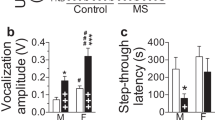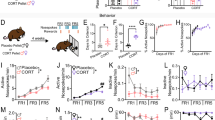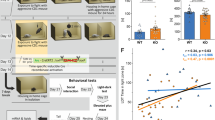Abstract
Corticotropin-releasing hormone (CRH) is a potent mediator of endocrine, autonomic, behavioural and immune responses to stress, and has been implicated in the stress-like and other aversive consequences of drug abuse, such as withdrawal from alcohol1,2. Two CRH receptors, Crhr1 and Crhr2, have been identified in the mouse3,4. Crhr1 is highly expressed in the anterior pituitary, neocortex, hippocampus, amygdala and cerebellum, and activation of this receptor stimulates adenylate cyclase5,6. Here we show that in mice lacking Crhr1, the medulla of the adrenal gland is atrophied and stress-induced release of adrenocorticotropic hormone (ACTH) and corticosterone is reduced. The homozygous mutants exhibit increased exploratory activity and reduced anxiety-related behaviour under both basal conditions and following alcohol withdrawal. Our results demonstrate a key role of the Crhr1 receptor in mediating the stress response and anxiety-related behaviour.
This is a preview of subscription content, access via your institution
Access options
Subscribe to this journal
Receive 12 print issues and online access
$209.00 per year
only $17.42 per issue
Buy this article
- Purchase on Springer Link
- Instant access to full article PDF
Prices may be subject to local taxes which are calculated during checkout





Similar content being viewed by others
References
Menzaghi, F. et al. The role of corticotropin-releasing factor in the anxiogenic effects of ethanol withdrawal. Ann. N. Y. Acad. Sci. 739, 176 –184 (1994).
Pich, E.M. et al. Increase of extracellular corticotropin-releasing factor-like immunoreactivity levels in the amygdala of awake rats during restraint stress and ethanol withdrawal as measured by microdialysis. J. Neurosci. 15, 5439–5447 (1995).
Vita, N. et al. Primary structure and functional expression of mouse pituitary and human brain corticotrophin releasing factor receptors. FEBS Lett. 335, 1–5 (1993).
Kishimoto, T Pearse, R.V. Lin C.R. Rosenfeld, M.G. A sauvagine/corticotropin-releasing factor receptor expressed in heart and skeletal muscle. Proc. Natl. Acad. Sci. USA 92, 1108–1112 (1995
Chalmers, D.T. Lovenberg, T.W. De Souza, E.B. Localization of novel corticotropin-releasing factor receptor (CRF2) mRNA expression to specific subcortical nuclei in rat brain: comparison with CRF1 receptor mRNA expression. J. Neurosci. 15, 6340–6350 (1995).
De Souza, E.B. Corticotropin-releasing factor receptors: physiology, pharmacology, biochemistry and role in central nervous system and immune disorders. Psychoneuroendocrinol. 20, 789–819 (1995).
Aguilera, G. Abou-Samra, A.B. Harwood, J.P. Catt, K.J. Corticotropin releasing factor receptors: characterization and actions in the anterior pituitary gland. Adv. Exp. Med. Biol. 245, 83–106 (1988).
Bilezikjian L.M. Vale, W.W. Glucocorticoids inhibit corticotropin-releasing factor-induced production of adenosine 3´,5´-monophosphate in cultured anterior pituitary cells. Endocrinol. 113, 657–662 (1983).
Vale,W. Spiess, J. Rivier, C. Rivier, J. Characterization of a 41-residue ovine hypothalamic peptide that stimulates secretion of corticotropin and beta-endorphin. Science 213, 1394–1397 (1981).
Holsboer, F. Spengler, D. Heuser, I. The role of corticotropin-releasing hormone in the pathogenesis of Cushing's disease, anorexia nervosa, alcoholism, affective disorders and dementia. Prog. Brain Res. 93, 385–416 (1992).
Owens, M.J. Nemeroff, C.B. Physiology and pharmacology of corticotropin-releasing factor. Pharmacol. Rev. 43, 425–473 (1991).
Swanson, L.W. Simmons, D.M. Differential steroid hormone and neural influences on peptide mRNA levels in CRH cells of the paraventricular nucleus: a hybridization histochemical study in the rat. J. Comp. Neurol. 285, 413–435 ( 1989).
Cole, T.J. et al. Targeted disruption of the glucocorticoid receptor gene blocks adrenergic chromaffin cell development and severely retards lung maturation. Genes Dev. 9, 1608–1621 (1995).
Edwards, A.V. Jones, C.T. The effect of splanchnic nerve section on the sensitivity of the adrenal cortex to adrenocorticotrophin in the calf. J. Physiol. 390, 23–31 (1987).
Bornstein, S.R. Ehrhart-Bornstein, M. Scherbaum, W.A. Pfeiffer, E.F. Holst, J.J. Effects of splanchnic nerve stimulation on the adrenal cortex may be mediated by chromaffin cells in a paracrine manner. Endocrinol. 127, 900–906 (1990).
Stenzel-Poore, M.P. Heinrichs, S.C. Rivest, S. Koob, G.F. Vale, W.W. Overproduction of corticotropin-releasing factor in transgenic mice: a genetic model of anxiogenic behavior. J. Neurosci. 14, 2579–2584 (1994).
Conti, L.H. et al. Mouse strain differences in the behavioral effects of corticotropin-releasing factor (CRH) and the CRH antagonist α-helical CRH9-41. Pharmacol. Biochem. Behav. 48, 497–503 (1994).
Moreau, J.L. Kilpatrick, G. Jenck, F. Urocortin, a novel neuropeptide with anxiogenic-like properties. Neuroreport 8, 1697–1701 (1997).
Liebsch, G. et al. Chronic infusion of a CRH1 receptor antisense oligodeoxynucleotide into the central nucleus of the amygdala reduced anxiety-related behavior in socially defeated rats. Regul. Pept. 59, 229–239 (1995).
Koob, G.F. Drug addiction: the yin and yang of hedonic homeostasis. Neuron 16, 893–896 (1996).
Rassnick, S. Heinrichs, S.C. Britton, K.T. Koob, G.F. Microinjection of a corticotropin-releasing factor antagonist into the central nucleus of the amygdala reverses anxiogenic-like effects of ethanol withdrawal. Brain Res. 605, 25–32 (1993).
Tabakoff, B. Hoffmann, P.L. Alcohol addiction: An enigma among us. Neuron 16, 909–912 (1996).
Evans, G.A. Lewis, K. Rothenberg, B.E. High efficiency vectors for cosmid microcloning and genomic analysis. Gene 79, 9–20 ( 1989).
Tybulewicz, V.L. Crawford, C.E. Jackson, P.K. Bronson, R.T Mulligan, R.C. Neonatal lethality and lymphopenia in mice with a homozygous disruption of the c-ab1 proto-oncogene. Cell 65,1153 –1163 ( 1991).
Wurst, W. Joyner, A.L. Production of targeted embryonic stem cell clones.in Gene Targeting, A Practical Approach (ed. Joyner, A.L.) 33–61 (IRL Press, Oxford, 1993).
Stalla, G.K. et al.Ketoconazole inhibts corticotropic cell function in vitro. Endocrinol. 122, 618–623 ( 1988).
Karanth, S. et al. Hypothalamic-pituitary-adrenocortical axis changes in a transgenic mouse with impaired glucocorticoid receptor function. Endocrinol. 138, 3476–3485 (1997).
Kresse, A. Jacobowitz, D.M. Skofitsch, G. Detailed mapping of CGRP mRNA expression in the rat central nervous system: Comparison with previous immunocytochemical findings. Brain Res. Bull. 36, 261–274 ( 1995).
Spanagel, R. Putzke, J. Stefferl, A. Schö,B. Zieglgängsberger, W. Acamprosate and alcohol: II. Effects on alcohol withdrawal in the rat. Eur. J. Pharmacol. 305, 45–50 (1996).
Crabbe, J.C. et al. Elevated alcohol consumption in null mutant mice lacking 5-HT1B serotonin receptors. Nature Genet. 14, 98–101 (1996).
Acknowledgements
The authors would like to thank J. Favor for analysis of the eyes, O.F.X. Almeida, L. Bally-Cuif and R. Landgraf for critically reviewing the manuscript, A. Yassouridis for statistical analysis, A. Seasholtz, M. Stenzel-Poore, J. Arriza, R. Miesfeld and Y.-A. Barde for the generous gift of cDNA probes; S. Bourier, P. Westphal, P. Surbir, S. Bicking, T. Pohl, J. Stalla and C. Weis for excellent technical assistance, and S. Rengsberger for preparing the manuscript. This work was supported by a grant from the Volkswagen Foundation (F.H. and W.W.) and the Bundesministerium für Bildung und Forschung (R.S.).
Author information
Authors and Affiliations
Corresponding author
Rights and permissions
About this article
Cite this article
Timpl, P., Spanagel, R., Sillaber, I. et al. Impaired stress response and reduced anxiety in mice lacking a functional corticotropin-releasing hormone receptor 1. Nat Genet 19, 162–166 (1998). https://doi.org/10.1038/520
Received:
Accepted:
Issue Date:
DOI: https://doi.org/10.1038/520
This article is cited by
-
Genetic Contributions to Attachment Stability Over Time: the Roles of CRHR1 Polymorphisms
Journal of Youth and Adolescence (2024)
-
Involvement of the ventral, but not dorsal, hippocampus in anxiety-like behaviors in mice exposed to the elevated plus maze: participation of CRF1 receptor and PKA pathway
Pharmacological Reports (2021)
-
Characterization and evaluation of the tissue distribution of CRH, apelin, and GnRH2 reveal responses to feeding states in Schizothorax davidi
Fish Physiology and Biochemistry (2021)
-
Roles for androgens in mediating the sex differences of neuroendocrine and behavioral stress responses
Biology of Sex Differences (2020)
-
Discovery of a stable tripeptide targeting the N-domain of CRF1 receptor
Amino Acids (2020)



